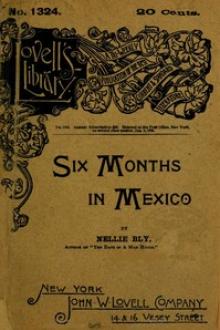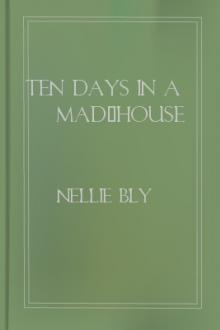Six Months in Mexico by Nellie Bly (best classic literature TXT) 📕

- Author: Nellie Bly
- Performer: -
Book online «Six Months in Mexico by Nellie Bly (best classic literature TXT) 📕». Author Nellie Bly
Out by the unlucky Cathedral we saw the hearse of the town. It is the shape of a coffin, held aloft by springs above four wheels. It is draped with crape and plumes. Two black mules, stuck with plumes on every available spot, draw it, and the driver, dressed in black with high hat decorated with a plume, handles the reins, perched on a small seat about four feet above the rest of the hearse. The coffin is slid in at the back or end like the case in which coffins are often hermetically sealed.
Selecting a poor street, we started to make our way toward the mountains. On it we found a row of houses numbered in the following style: January 1, February 2, March 3, April 4, May 5, June 6, July 7, August 8. September 9, October 10, November 11, December 12. Still further down we saw one called “The place of Providence,” each different door designated as “The place of Providence A, the place of Providence B,” and so on throughout the alphabet. Next we came to a laundry which did not remind us in the least of those at home. The river was the tub, a porous stone the washboard, and the little bushes and green bank the clothesline. In this manner all the washing of the town is done. We admired the washwomen for quite a while as they rubbed the clothes on the stone and then doused them up and down in the stream.
At last we concluded to jump across and go down on the other side, but we forgot we were women and that the dress of last fall was extremely narrow. We jumped from one washboard to another. We landed on it all right, but we did not stay long, but slipped back into the water, which was about three feet deep, much to our consternation. On our way home we stopped at the Tivoli, the bath-house and the main alameda, which is situated at the foot of an immense mountain, and is said to be one of the prettiest in the republic. The walks and drives are wide and nicely paved, a great variety of trees furnish the shade and musical fountains are plentiful. A music stand is in the center and is occupied nightly by a good band. The water-carriers were getting their supply from one of the large basins; they were also different from others we have seen. They have a long pole across their shoulders, and suspended from each end is a bucket containing the water, after the style of the milkmaids in the States. It seems strange that though every city has its water-carriers and that every one in the same town carries exactly alike, yet in no two towns do they carry in the same manner.
I cannot forget to introduce you to the pleasant gentleman we met on the train. He is Mr. A. Baker, Her Britannic Majesty’s Consul at Vera Cruz. He speaks fluently fifteen different languages, and when I asked him if he was not very proud of the fact, he replied: “Yes, until I met a waiter in a restaurant who could speak eighteen.” He is a widower, and came here accompanied by his only son, while his three daughters are at school in Europe. The common expression made of him here is, that “he is good enough for an American.” Now you can judge how agreeable he is. He has been knighted three different times, and was colonel in two different armies, yet he is still plain Mr. Baker. “Oh, I had ancestors,” he said, jokingly, as we were discussing people’s little vanities, “and they came over in the ship of the conquerors, also. My forefather was a cook. One day the bread was exhausted, and there was no way to procure more, so the cook made some pancakes, and waited in terror while they were taken in to his majesty. At last he got a summons to appear before him; trembling and expecting to be beheaded, the poor fellow sank at his sovereign’s feet, when, instead of a sentence to be executed, he heard: ‘Rise, Sir Baker.’ Since then that has been the family name.”
Accompanied by Mr. Baker, we started north to see a waterfall, and to take the train at the next station. We got in a car and went winding in between the high mountains from which the black marble is quarried until we reached a stretch of land, where we alighted and crossed the fields until we came to that wonderful stream. The water is quite cold and mineral, and as clear as crystal, one being able to see the bottom at the depth of twenty feet as though there was no water intervening. Down where the water was more shallow were several horses fishing for the grass that grows in the bottom; they thrust in their heads until their eyes were in the water, and then pulled out a mouthful of grass; they made a beautiful picture. Baths are situated here, and trees grow around just plentiful enough to be pretty. Foot logs span the stream, and the cool, green, velvety plots invite a longer stay.
On one foot log we discovered what appeared to be walking leaves, as the green leaves glided along, moved by an unseen power. Investigation proved them to be an army of ants, each one carrying a leaf on its back which looked like a little sail. On the edge of the bank, half in the water, half out, lay a branch of willow. These little things climbed, it, risking life and limb, and, cutting off a leaf, hoisted it on their backs and marched easily a quarter of a mile to their home. They had a path of road about five inches wide made along the grass all the distance. The street cleaners must be faithful, as it was as clean as could be, shaded on either side by the grass, without one blade in their way. They crossed the foot log and disappeared in a hole at the other end. We wondered what they were making inside with those many leaves. They were so interesting at their work that it was with reluctance we left them. Boarding our train, with much regret, we were soon lost to sight of the Valley of Orizaba and were once more on our way to a new and strange city.
CHAPTER XXII.
THE WONDERS OF PUEBLA.
IF the innocent-looking tourists believed all that is told them here they would conclude that every spot and town of interest had been built by the Virgin and the angels. One night many, many years ago, so the story runs, one good priest, who was known by the name of Motolinia, which means humble, mean, lowly, had a vision. A number of sweet angels - all of the feminine gender - draped with some soft, thin material, with long, silky black hair that fell to their feet in heavy folds, and sparkling black eyes, took the good father in their arms and bore him through the air to a spot not far distant from his little hut. After setting up a stone cross, which, at their petition, apparently descended from the skies, they helped him to build churches, houses, factories, and bull-rings (perhaps). It took seven days and the same number of nights to build the world, but the city of Puebla was built in a few moments. Probably the fatigue from work or the unusual company made the good man tired and drowsy, so he fell asleep, as sweetly as a babe, fanned by the wings of the heavenly beings around him. Waking from a most refreshing nap, in which he had dreamed of honey, golden crowns, feathered wings, and regiments of beautiful creatures, he found to his surprise that he was once again in his little bed, with no angels in sight. “They hare gone out to complete the work, while I, lazy creature, slept,” thought the good father, and going to the window he flung it open. He saw the green plain undisturbed.
At first he was surprised and disappointed, and had he been a dyspeptic all would have ended there, and this story would not have to be told; but, like a good and faithful believer, he worked out a solution of the strange vision, which was that the angels had appeared to show they wanted the work done and how, but he must accomplish it himself. To prove beyond doubt their visit, the stone cross was left standing where their angelic hands had placed it. So encouraged, and with great faith, he related his vision to the people, and with their aid began to build the city of Puebla around the stone cross, leaving more than a square vacant where it stood. This was three hundred and fifty-five years ago, on the 16th of April. The square is now used for the city market, and the stone cross, revered and respected, is standing in the courtyard of what was the convent of Santo Domingo, but now a church, where at the same place they will take from the altar and show you a coat which was once worn by a very holy monk, and for some good act the Virgin stamped her picture on the sleeve of it. It is very interesting to look at, even if one be so unfortunate as to possess but little faith; the most interesting thing in Puebla is its churches. Every one has some wonderful tale attached.
Puebla was named in honor of its first visitors, Puebla de los Angles (Town of the Angels), but it is very seldom spoken of except as Puebla. The corner-stone of the first church was laid in 1531, and that of the first cathedral in 1536. Both of these buildings have disappeared, as they were originally, though it is proven that part of the former is the present Sagrario, covered with parasites and in almost utter ruins. The present cathedral was finished in 1649, and is one of the finest and most expensive in Mexico. One of its towers alone cost $100,000. The high altar, composed of Mexican marble and onyx, is one of the finest ever constructed. It is said to have cost $200,000. This altar, before the reform, was loaded with gold, silver, and jewels. The bishops’ sepulcher is beneath. A beautiful carving in ivory of the Virgin, which was completed after three years’ hard labor, and a wonderful curtain, which was a present from the King of Spain, as well as the dungeons beneath, are a few of the things worth seeing. It has eighteen bells. The largest weighs nine tons.
The Chapel of Conquistadora contains an image of the Senora de los Remedios, which was presented by Cortes to the Hascallan, Don Axotecatl Cocomitzin, for his good help and friendship during the time of the bitter war with the other natives. Upon the main altar lie the remains of the man who first introduced oxen into Mexico, and who for many years was the means of passage and communication between Mexico and Vera Cruz. His name was Sebastian de Aparicio. He was born in 1502, and died, after living a good and useful life, in 1600. At the Dominican Monastery they showed half the handkerchief on which the Virgin wept and wiped her eyes at the foot of the cross. The people claim that San Jose protects their town from lightning, so they built a church





Comments (0)